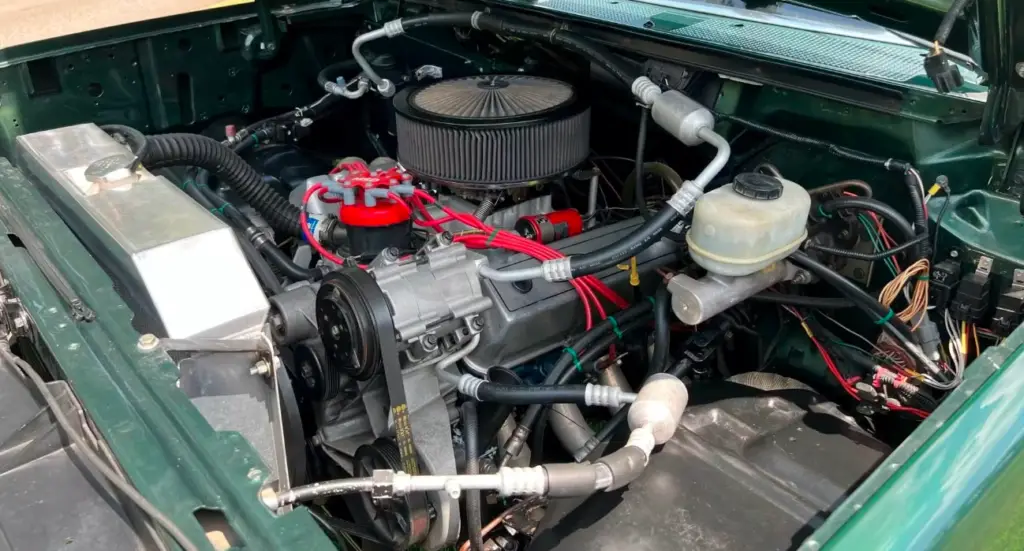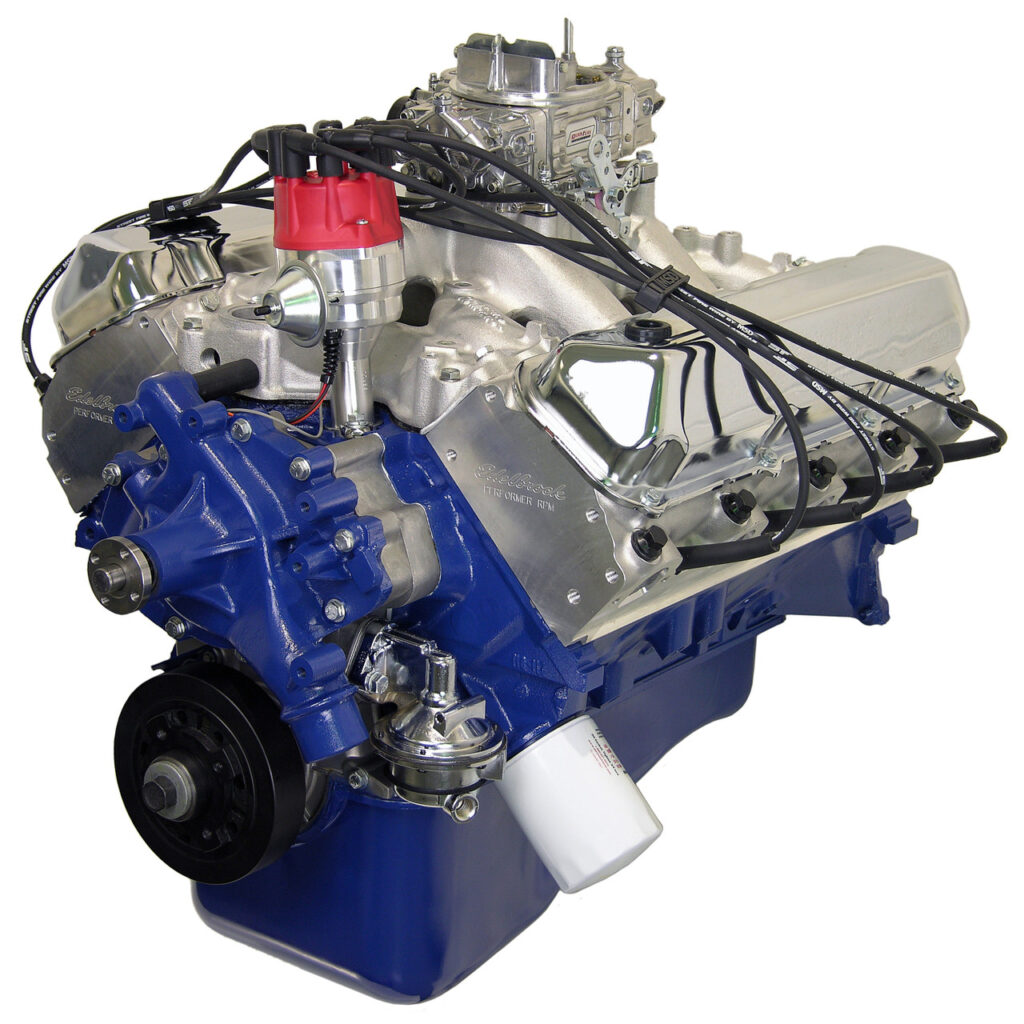The Ford 460 is a 7.5L V8 engine known for its high torque, with up to 365 horsepower in early models and 245-275 horsepower in later versions, mainly used in trucks and motorhomes.
The Ford 460 engine, one of the most iconic big-block V8 engines, has earned a reputation for its massive power, reliability, and versatility. Initially introduced in the late 1960s, the 460 remained in production until the mid-1990s, powering a range of Ford trucks, large cars, and even performance vehicles. Its robust design, high torque output, and adaptability make it a favorite among engine builders and performance enthusiasts.
In this blog post, we’ll take a closer look at the specifications of the Ford 460 engine, discuss its history, applications, and modifications, and answer some of the most frequently asked questions (FAQs) related to this powerhouse.

Contents
History of the Ford 460 Engine
Ford’s 460-cubic-inch V8 was part of the Ford “385” engine family, which also included engines like the 429 V8. These big-block engines were designed for large vehicles that needed substantial power and torque, especially for towing and hauling purposes.
Introduction: The 460 engine was introduced in 1968 and was initially used in Ford’s larger sedans, such as the Lincoln Continental and the Ford Thunderbird. Its primary market was for luxury cars, where a smooth, high-torque engine was needed to move heavy vehicles effortlessly.
Transition to Trucks: In the 1970s, the 460 found its way into Ford trucks, where it became popular among users who needed significant towing capacity. It became a staple for Ford F-Series trucks, motorhomes, and other large utility vehicles.
The End of Production: Ford produced the 460 engine until 1997. As emission regulations became stricter and smaller, more fuel-efficient engines became popular, the demand for the large-displacement big block V8s like the 460 diminished. However, despite its official retirement, the 460 engine remains a favorite among enthusiasts for rebuilding and modifications due to its durability and power potential.
Ford 460 Engine Specifications
Here’s a breakdown of the Ford 460 engine’s specs, focusing on key details that made it a favorite among truck owners and performance enthusiasts:
1. Displacement
- Cubic Inches: 460
- Liters: 7.5 L
The 460 refers to its displacement in cubic inches, with the engine having a large bore and stroke, resulting in 7.5 liters of displacement. This large displacement contributes to its ability to generate significant amounts of low-end torque, which made it particularly well-suited for heavy vehicles.
2. Bore and Stroke
- Bore: 4.36 inches (111 mm)
- Stroke: 3.85 inches (98 mm)
The 460 features a relatively large bore combined with a long stroke. This bore and stroke ratio provides the engine with a torque-heavy powerband, perfect for pulling heavy loads or achieving high acceleration in performance cars.
3. Compression Ratio
- Compression Ratio: 8.0:1 to 10.5:1 (varied by year and model)
The compression ratio of the Ford 460 engine varied depending on the year and application. Early versions of the engine, especially those used in cars, had higher compression ratios to produce more power. As emissions standards tightened, the compression ratio was lowered to meet new regulations, reducing horsepower but improving fuel efficiency and emissions control.
4. Horsepower and Torque
- Horsepower (Early Models): 365 HP @ 4600 RPM (1970 Lincoln Mark III)
- Horsepower (Later Models): 245-275 HP @ 4200 RPM (1990s F-Series Trucks)
- Torque: 485 lb-ft @ 2800 RPM (early versions)
The Ford 460 was known for its torque, which was one of its key selling points for truck buyers and people using the engine in heavy-duty applications. In its prime, the 460 delivered over 500 lb-ft of torque in certain models. Even in its later years, when emissions regulations reduced its power output, the 460 still delivered impressive torque.
5. Fuel System
- Carburetor: Used in early versions until the early 1980s.
- Fuel Injection: Introduced in the mid-1980s for improved fuel economy and emissions.
The Ford 460 began with a traditional carburetor system. However, in the mid-1980s, Ford started implementing fuel injection in its engines, which helped meet stricter emissions standards while slightly improving fuel efficiency.
6. Valvetrain
- Valvetrain Type: Overhead valve (OHV), 2 valves per cylinder
- Lifters: Hydraulic flat-tappet lifters
The 460 features a simple overhead valve design with two valves per cylinder, which was typical of most large-displacement engines of the time. This setup contributed to its reliability and ease of maintenance.
Applications of the Ford 460 Engine
The Ford 460 engine was versatile and used in a variety of applications, including:
- Ford and Lincoln Cars: The 460 was initially introduced in luxury cars like the Lincoln Continental and the Ford Thunderbird. It provided the smooth, powerful acceleration needed for these large, heavy vehicles.
- Ford Trucks and Motorhomes: The engine became popular in Ford’s F-Series trucks and was often used in motorhomes. The high torque made it ideal for towing and carrying heavy loads.
- Performance and Racing: Some performance enthusiasts have modified the 460 for racing applications. With its large displacement, the 460 can be easily stroked and bored out to displacements of over 500 cubic inches, making it an excellent platform for high-horsepower builds.
- Industrial Applications: The 460 was sometimes used in industrial machinery and other heavy-duty applications where reliable, high-torque engines were necessary.

Modifying the Ford 460 Engine
One of the reasons the Ford 460 remains popular among car and truck enthusiasts is its modifiability. Here are some common modifications:
Boring and Stroking
Enthusiasts often bore and stroke the 460 to increase displacement. By installing a longer-stroke crankshaft and larger pistons, displacements of over 500 cubic inches can be achieved, resulting in massive power increases.
Aftermarket Heads
One of the most common upgrades is installing aftermarket cylinder heads. Aluminum heads with larger ports improve airflow, resulting in significant gains in horsepower and torque.
Camshaft Upgrades
Installing a performance camshaft can drastically change the power characteristics of the engine. Performance camshafts often provide higher lift and longer duration, which improves high-RPM power.
Fuel Injection Conversions
Older carbureted 460 engines can be converted to fuel injection. Fuel injection offers more precise fuel metering, which improves fuel efficiency and throttle response.
Forced Induction
Some enthusiasts add turbochargers or superchargers to their 460 engines. The large displacement and robust design of the engine make it well-suited for forced induction, which can provide massive horsepower gains.
Frequently Asked Questions
Here are some FAQs about ford 460 engine specs –
1. What vehicles came with the Ford 460 engine?
The Ford 460 engine was used in a wide range of vehicles, including the Lincoln Continental, Ford Thunderbird, Ford F-Series trucks, motorhomes, and some industrial applications.
2. How much horsepower does a stock Ford 460 have?
Horsepower varied by year and application. Early versions of the engine produced up to 365 horsepower, while later versions designed for trucks and motorhomes produced between 245 and 275 horsepower.
3. Is the Ford 460 a good engine for towing?
Yes, the Ford 460 is excellent for towing. Its high torque output, especially at low RPMs, makes it ideal for hauling heavy loads, which is why it was used extensively in Ford trucks and motorhomes.
4. Can you increase the displacement of a Ford 460 engine?
Yes, the 460 can be easily bored and stroked to increase displacement. Many enthusiasts build 460 engines with displacements exceeding 500 cubic inches for more power.
5. What fuel system does the Ford 460 use?
Early versions of the Ford 460 used a carburetor, but Ford introduced fuel injection in the mid-1980s, which improved fuel economy and emissions performance.
Conclusion
The Ford 460 engine has earned its place as a legendary big-block V8, thanks to its immense power, torque, and versatility. Whether used for towing, racing, or as a platform for performance modifications, the 460 remains a favorite among engine builders and enthusiasts. Its robust design, combined with its ease of modification, ensures that the legacy of the Ford 460 continues to thrive in the automotive world.